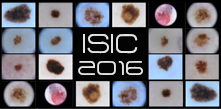
Wednesday, 13 April, 8:30am-12:15pm
Organizers
- Colin Jacobs (Radboud University Medical Center, Nijmegen, The Netherlands)
- Arnaud Arindra Adiyoso Setio (Radboud University Medical Center, Nijmegen, The Netherlands)
- Alberto Traverso (Polytechnic University of Turin and Turin Section of INFN, Turin, Italy)
- Bram van Ginneken (Radboud University Medical Center, Nijmegen, The Netherlands)
Challenge website
Challenge abstract
Lung cancer is the leading cause of cancer-related death worldwide. The National Lung Screening Trial (NLST), a randomized control trial in the U.S. including more than 50,000 high-risk subjects, showed that lung cancer screening using annual low-dose computed tomography (CT) reduces lung cancer mortality by 20% in comparison to annual screening with chest radiography. In 2013, the U.S. Preventive Services Task Force (USPSTF) has given low-dose CT screening a grade B recommendation for high-risk individuals and early 2015, the U.S. Centers for Medicare and Medicaid Services (CMS) has approved CT lung cancer screening for Medicare recipients. As a result of these developments, lung cancer screening programs using low-dose CT are being implemented in the United States and other countries.
The upcoming Coding4Cancer challenge invites coders to create the best computer algorithm that can identify a person as having lung cancer based on one or multiple low-dose CT images. To be able to detect lung cancer in an early stage, pulmonary nodules, the early manifestation of lung cancers, have to be detected and suspicious nodules need to be followed up. To efficiently detect nodules, a large number of automatic Computer-aided detection (CAD) systems have been proposed. However, large evaluation studies investigating the performance of different state-of-the-art CAD systems are scarce. The LUNA16 challenge will focus on a large-scale evaluation of automatic nodule detection algorithms on the publicly available LIDC-IDRI dataset.
Other challenges
 |
Cancer Metastasis Detection in Lymph Nodes (CAMELYON) |
 |
Analysis of Images to Detect Abnormalities in Endoscopy (AIDA-E) |
 |
Skin Lesion Analysis towards Melanoma Detection |
